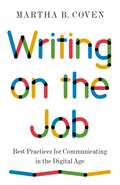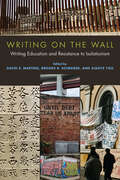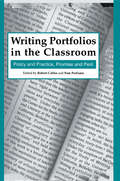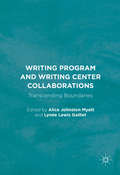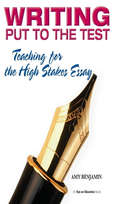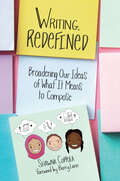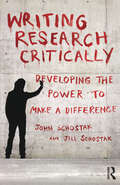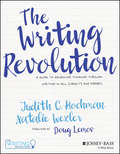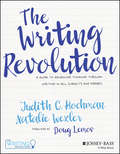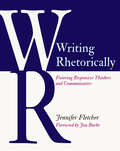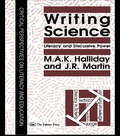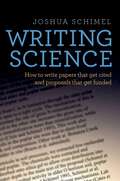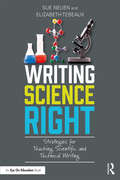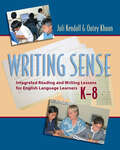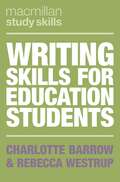- Table View
- List View
Writing on the Job: Best Practices for Communicating in the Digital Age
by Martha B. CovenA practical and compact guide to writing for professionalsWriting is an essential skill in today’s workplace. From messaging platforms and social media to traditional forms of communication like memos and reports, we rely on words more than ever. Given how much reading we do on mobile devices, being able to write succinctly is critical to success. Writing on the Job is an incisive guide to clear and effective writing for professionals.Martha Coven begins with the basics, explaining how to develop a professional style, get started on a piece of writing, create a first draft, and edit it into a strong final product. She then offers practical advice on more than a dozen forms of writing, from emails and slide decks to proposals and cover letters. Along the way, Coven provides a wealth of concrete examples and simple templates that make the concepts easy to understand and apply.Based on Coven’s popular writing classes and workshops at Princeton University as well as her decades of experience in the public and private sectors, Writing on the Job addresses the real challenges professionals face in today’s digital age, and shares essential practices that can improve the performance of any organization.
Writing on the Job: Best Practices for Communicating in the Digital Age
by Martha B. CovenA practical and compact guide to writing for professionalsWriting is an essential skill in today’s workplace. From messaging platforms and social media to traditional forms of communication like memos and reports, we rely on words more than ever. Given how much reading we do on mobile devices, being able to write succinctly is critical to success. Writing on the Job is an incisive guide to clear and effective writing for professionals.Martha Coven begins with the basics, explaining how to develop a professional style, get started on a piece of writing, create a first draft, and edit it into a strong final product. She then offers practical advice on more than a dozen forms of writing, from emails and slide decks to proposals and cover letters. Along the way, Coven provides a wealth of concrete examples and simple templates that make the concepts easy to understand and apply.Based on Coven’s popular writing classes and workshops at Princeton University as well as her decades of experience in the public and private sectors, Writing on the Job addresses the real challenges professionals face in today’s digital age, and shares essential practices that can improve the performance of any organization.
Writing on the Wall: Writing Education and Resistance to Isolationism
by Xiaoye You David S. Martins Brooke R. SchreiberThe first concerted effort of writing studies scholars to interrogate isolationism in the United States, Writing on the Wall reveals how writing teachers—often working directly with students who are immigrants, undocumented, first-generation, international, and students of color—embody ideas that counter isolationism. The collection extends existing scholarship and research about the ways racist and colonial rhetorics impact writing education; the impact of translingual, transnational, and cosmopolitan ideologies on student learning and student writing; and the role international educational partnerships play in pushing back against isolationist ideologies. Established and early-career scholars who work in a broad range of institutional contexts highlight the historical connections among monolingualism, racism, and white nationalism and introduce community- and classroom-based practices that writing teachers use to resist isolationist beliefs and tendencies. “Writing on the wall” serves as a metaphor for the creative, direct action writing education can provide and invokes border spaces as sites of identity expression, belonging, and resistance. The book connects transnational writing education with the fight for racial justice in the US and around the world and will be of significance to secondary and postsecondary writing teachers and graduate students in English, linguistics, composition, and literacy studies. Contributors: Olga Aksakalova, Sara P. Alvarez, Brody Bluemel, Tuli Chatterji, Keith Gilyard, Joleen Hanson, Florianne Jimenez Perzan, Rebecca Lorimer Leonard, Layli Maria Miron, Tony D. Scott, Kate Vieira, Amy J. Wan
Writing Portfolios in the Classroom: Policy and Practice, Promise and Peril
by Robert C. Calfee Pamela PerfumoThis volume presents chapters by researchers, practitioners, and policymakers who study the impact of classroom portfolios in the assessment of writing achievement by elementary and middle grade students. The focus throughout the volume is on the tension between classroom assessment and externally mandated testing. It presents the efforts of researchers, practitioners, and policymakers to understand the impact of classroom portfolios for the assessment of writing achievement by elementary and middle grade students. Under the auspices of the Center for the Study of Writing, the editors conducted a national survey of exemplary portfolio projects, arranged for a series of "video visits," and held several working conferences. The result of this work is a broad-ranging tale: the aspirations of teachers and administrators to move the machinery of schooling in the direction of more authentic and engaging tasks, the puzzlement of students when they realize that the assignments are real and that the teacher may not have a "right answer" in mind, and the tensions between ivory-tower ideas and everyday classroom practice. Divided into four sections, this research volume: * provides a historical perspective, develops the conceptual framework that serves as a background for many activities described throughout, and discusses numerous practical issues that confront today's researchers and practitioners; * views the phenomenon of writing portfolios through a variety of broadview lenses such as teacher enthusiasm, student reflection, assessment tension, the portfolio as metaphor, and the locus of control; * conveys important conceptual issues with a balance toward pragmatics; and * offers unique insights from the perspective of one individual who serves as scholar, researcher, and teacher.
Writing Portfolios in the Classroom: Policy and Practice, Promise and Peril
by Robert Calfee Pamela PerfumoThis volume presents chapters by researchers, practitioners, and policymakers who study the impact of classroom portfolios in the assessment of writing achievement by elementary and middle grade students. The focus throughout the volume is on the tension between classroom assessment and externally mandated testing. It presents the efforts of researchers, practitioners, and policymakers to understand the impact of classroom portfolios for the assessment of writing achievement by elementary and middle grade students. Under the auspices of the Center for the Study of Writing, the editors conducted a national survey of exemplary portfolio projects, arranged for a series of "video visits," and held several working conferences. The result of this work is a broad-ranging tale: the aspirations of teachers and administrators to move the machinery of schooling in the direction of more authentic and engaging tasks, the puzzlement of students when they realize that the assignments are real and that the teacher may not have a "right answer" in mind, and the tensions between ivory-tower ideas and everyday classroom practice. Divided into four sections, this research volume: * provides a historical perspective, develops the conceptual framework that serves as a background for many activities described throughout, and discusses numerous practical issues that confront today's researchers and practitioners; * views the phenomenon of writing portfolios through a variety of broadview lenses such as teacher enthusiasm, student reflection, assessment tension, the portfolio as metaphor, and the locus of control; * conveys important conceptual issues with a balance toward pragmatics; and * offers unique insights from the perspective of one individual who serves as scholar, researcher, and teacher.
Writing Program and Writing Center Collaborations: Transcending Boundaries
by Alice Johnston Myatt Lynée Lewis GailletThis book demonstrates how to develop and engage in successful academic collaborations that are both practical and sustainable across campuses and within local communities. Authored by experienced writing program administrators, this edited collection includes a wide range of information addressing collaborative partnerships and projects, theoretical explorations of collaborative praxis, and strategies for sustaining collaborative initiatives. Contributors offer case studies of writing program collaborations and honestly address both the challenges of academic collaboration and the hallmarks of successful partnerships.
Writing Put to the Test: Teaching for the High Stakes Essay
by Amy BenjaminThis book helps educators improve students’ ability to write clear, coherent essays in response to on-demand writing prompts. While it focuses on students’ abilities to succeed at on-demand writing, it also promotes the teaching of writing as an expression of art and self. For grades 4 -12, it provides examples of responses to narrative and persuasive prompts, and provides savvy advice about what scorers look for.
Writing Put to the Test: Teaching for the High Stakes Essay
by Amy BenjaminThis book helps educators improve students’ ability to write clear, coherent essays in response to on-demand writing prompts. While it focuses on students’ abilities to succeed at on-demand writing, it also promotes the teaching of writing as an expression of art and self. For grades 4 -12, it provides examples of responses to narrative and persuasive prompts, and provides savvy advice about what scorers look for.
Writing, Redefined: Broadening Our Ideas of What It Means to Compose
by Shawna CoppolaWhat does it mean to write or to be a writer? In Shawna Coppola's book Writing, Redefined: Broadening Our Ideas of What It Means to Compose, she challenges the reader to expand beyond standard alphabetic writing and consider alternative forms of composition when assigning writing to students. This book empowers teachers to change what counts as writing in schools and classrooms, opening the door to students who may not consider themselves to be writers, but should and can. Inside you'll find alternative, engaging writing assignments that are visual, aural, or multimodal that will involve all students, specifically those: Who prefer to compose using a wider array of forms and modes For whom standard English is not the norm Who have been identified as dyslexic Whose cultural traditions lean heavily towards more aural forms of composition Who are considered struggling writers By finding ways to accommodate all styles of writers, students are free to unleash their creativity and share their story with others. While there is no question composition in written form is important and worth of study, broadening our definition of writing expands an enormous range of possibilities for composing for all students.
Writing, Redefined: Broadening Our Ideas of What It Means to Compose
by Shawna CoppolaWhat does it mean to write or to be a writer? In Shawna Coppola's book Writing, Redefined: Broadening Our Ideas of What It Means to Compose, she challenges the reader to expand beyond standard alphabetic writing and consider alternative forms of composition when assigning writing to students. This book empowers teachers to change what counts as writing in schools and classrooms, opening the door to students who may not consider themselves to be writers, but should and can. Inside you'll find alternative, engaging writing assignments that are visual, aural, or multimodal that will involve all students, specifically those: Who prefer to compose using a wider array of forms and modes For whom standard English is not the norm Who have been identified as dyslexic Whose cultural traditions lean heavily towards more aural forms of composition Who are considered struggling writers By finding ways to accommodate all styles of writers, students are free to unleash their creativity and share their story with others. While there is no question composition in written form is important and worth of study, broadening our definition of writing expands an enormous range of possibilities for composing for all students.
Writing Research Critically: Developing the power to make a difference
by John Schostak Jill SchostakThis is not a standard guide to writing a dissertation, thesis, project report, journal article or book. Rather, this book will help researchers who are dissatisfied with the typical recipe approaches to standardised forms of writing-up and want to explore how academic writing can be used to greater effect. Writing Research Critically shows that writing up is not just about ‘presenting findings’ as if the facts would speak for themselves. As the authors show there are certain vital skills that any writer needs to develop within their academic writing, such as the ability to: develop critical understanding and a personal academic voice question assumptions and the status quo frame the background and transgress the frame read between the lines when reviewing the literature strengthen interpretations and conctruct persuasive arguments challenge and develop theory and explanations develop ideas that create possibilities for realistic action Packed with examples from a range of writing projects (papers, dissertations, theses, reports, journal articles and books), this book provides a practical and refreshing way to approach and present research. Through case studies the authors offer a step-by-step guide from the early stages of planning a writing project, whether an undergraduate paper or a professional publication, to the polishing processes that make the difference between a merely descriptive account to an argument that intends to be critical and persuasive. Written in a clear accessible style this book will inspire a wide range of researchers from undergraduates to postgraduates, early career researchers and experienced professionals working across a wide range of fields, and demonstrate how research can have more impact in the real world.
Writing Research Critically: Developing the power to make a difference
by John Schostak Jill SchostakThis is not a standard guide to writing a dissertation, thesis, project report, journal article or book. Rather, this book will help researchers who are dissatisfied with the typical recipe approaches to standardised forms of writing-up and want to explore how academic writing can be used to greater effect. Writing Research Critically shows that writing up is not just about ‘presenting findings’ as if the facts would speak for themselves. As the authors show there are certain vital skills that any writer needs to develop within their academic writing, such as the ability to: develop critical understanding and a personal academic voice question assumptions and the status quo frame the background and transgress the frame read between the lines when reviewing the literature strengthen interpretations and conctruct persuasive arguments challenge and develop theory and explanations develop ideas that create possibilities for realistic action Packed with examples from a range of writing projects (papers, dissertations, theses, reports, journal articles and books), this book provides a practical and refreshing way to approach and present research. Through case studies the authors offer a step-by-step guide from the early stages of planning a writing project, whether an undergraduate paper or a professional publication, to the polishing processes that make the difference between a merely descriptive account to an argument that intends to be critical and persuasive. Written in a clear accessible style this book will inspire a wide range of researchers from undergraduates to postgraduates, early career researchers and experienced professionals working across a wide range of fields, and demonstrate how research can have more impact in the real world.
The Writing Revolution: A Guide to Advancing Thinking Through Writing in All Subjects and Grades
by Natalie Wexler Judith C. Hochman"HELP! My Students Can't Write!" Why You Need a Writing Revolution in Your Classroom and How to Lead It. The Writing Revolution (TWR) provides a clear method of instruction that you can use no matter what subject or grade level you teach. The model, also known as The Hochman Method, has demonstrated, over and over, that it can turn weak writers into strong communicators by focusing on specific techniques that match their needs and by providing them with targeted feedback. Insurmountable as the challenges faced by many students may seem, TWR can make a dramatic difference. And the method does more than improve writing skills. It also helps: Boost reading comprehension Improve organizational and study skills Enhance speaking abilities Develop analytical capabilities TWR is as much a method of teaching content as it is a method of teaching writing. There's no separate writing block and no separate writing curriculum. Instead, teachers of all subjects adapt the TWR strategies and activities to their current curriculum and weave them into their content instruction. But perhaps what's most revolutionary about the TWR method is that it takes the mystery out of learning to write well. It breaks the writing process down into manageable chunks and then has students practice the chunks they need, repeatedly, while also learning content.
The Writing Revolution: A Guide to Advancing Thinking Through Writing in All Subjects and Grades
by Natalie Wexler Judith C. Hochman"HELP! My Students Can't Write!" Why You Need a Writing Revolution in Your Classroom and How to Lead It. The Writing Revolution (TWR) provides a clear method of instruction that you can use no matter what subject or grade level you teach. The model, also known as The Hochman Method, has demonstrated, over and over, that it can turn weak writers into strong communicators by focusing on specific techniques that match their needs and by providing them with targeted feedback. Insurmountable as the challenges faced by many students may seem, TWR can make a dramatic difference. And the method does more than improve writing skills. It also helps: Boost reading comprehension Improve organizational and study skills Enhance speaking abilities Develop analytical capabilities TWR is as much a method of teaching content as it is a method of teaching writing. There's no separate writing block and no separate writing curriculum. Instead, teachers of all subjects adapt the TWR strategies and activities to their current curriculum and weave them into their content instruction. But perhaps what's most revolutionary about the TWR method is that it takes the mystery out of learning to write well. It breaks the writing process down into manageable chunks and then has students practice the chunks they need, repeatedly, while also learning content.
Writing Rhetorically: Fostering Responsive Thinkers and Communicators
by Jennifer FletcherWriting Rhetorically: Fostering Responsive Thinkers and Communicators, author Jennifer Fletcher aims to cultivate independent learners through rhetorical thinking. She provides teachers with strategies and frameworks for writing instruction that can be applied across multiple subjects and lesson plans. Students learn to discover their own questions, design their own inquiry process, develop their own positions and purposes, make their own choices about content and form, and contribute to conversations that matter to them. Inside this book, Fletcher helps remove some of the scaffolding and explains how to put in practice some methods which can successfully foster: Inquiry, Invention, and Rhetorical Thinking Writing for Transfer Paraphrasing, Summary, Synthesis, and Citation Skills Research Skills and Processes Evidence-Based Reasoning Rhetorical Decision Making' Rhetorical decision making helps students develop the skills, knowledge, and mindsets needed for transfer of learning: the ability to adapt and apply learning in new settings. The more choices students make as writers, the better prepared they are to analyze and respond to diverse rhetorical situations.' Writing Rhetorically' shows teachers what it looks like to dig into real texts with students and novice writers and how it develops them for lifelong learning.
Writing Rhetorically: Fostering Responsive Thinkers and Communicators
by Jennifer FletcherWriting Rhetorically: Fostering Responsive Thinkers and Communicators, author Jennifer Fletcher aims to cultivate independent learners through rhetorical thinking. She provides teachers with strategies and frameworks for writing instruction that can be applied across multiple subjects and lesson plans. Students learn to discover their own questions, design their own inquiry process, develop their own positions and purposes, make their own choices about content and form, and contribute to conversations that matter to them. Inside this book, Fletcher helps remove some of the scaffolding and explains how to put in practice some methods which can successfully foster: Inquiry, Invention, and Rhetorical Thinking Writing for Transfer Paraphrasing, Summary, Synthesis, and Citation Skills Research Skills and Processes Evidence-Based Reasoning Rhetorical Decision Making' Rhetorical decision making helps students develop the skills, knowledge, and mindsets needed for transfer of learning: the ability to adapt and apply learning in new settings. The more choices students make as writers, the better prepared they are to analyze and respond to diverse rhetorical situations.' Writing Rhetorically' shows teachers what it looks like to dig into real texts with students and novice writers and how it develops them for lifelong learning.
Writing Science: Literacy And Discursive Power (Pitt Comp Literacy Culture Ser.)
by M.A.K. Halliday J.R. MartinThis book is about the use of language in the science classroom. It discusses the evolution of scientific discourse for learning in secondary schools, and examines the form and function of language across a variety of levels including lexiogrammar, discourse semantics, register, genre and ideology. Special attention is paid to how this knowledge is imparted. It will be of particular interest to educators involved with linguistics and/or science curriculum and teachers of English for special and academic purposes.; It is aimed at teachers of undergraduates in science and literacy, linguists teaching in English for special and academic purposes and students in higher education with an interest in science and literacy.
Writing Science: Literacy And Discursive Power
by M.A.K. Halliday J.R. MartinThis book is about the use of language in the science classroom. It discusses the evolution of scientific discourse for learning in secondary schools, and examines the form and function of language across a variety of levels including lexiogrammar, discourse semantics, register, genre and ideology. Special attention is paid to how this knowledge is imparted. It will be of particular interest to educators involved with linguistics and/or science curriculum and teachers of English for special and academic purposes.; It is aimed at teachers of undergraduates in science and literacy, linguists teaching in English for special and academic purposes and students in higher education with an interest in science and literacy.
Writing Science: How to Write Papers That Get Cited and Proposals That Get Funded
by Joshua SchimelAs a scientist, you are a professional writer: your career is built on successful proposals and papers. Success isn't defined by getting papers into print, but by getting them into the reader's consciousness. Writing Science is built upon the idea that successful science writing tells a story. It uses that insight to discuss how to write more effectively. Integrating lessons from other genres of writing with those from the author's years of experience as author, reviewer, and editor, the book shows scientists and students how to present their research in a way that is clear and that will maximize reader comprehension. The book takes an integrated approach, using the principles of story structure to discuss every aspect of successful science writing, from the overall structure of a paper or proposal to individual sections, paragraphs, sentences, and words. It begins by building core arguments, analyzing why some stories are engaging and memorable while others are quickly forgotten, and proceeds to the elements of story structure, showing how the structures scientists and researchers use in papers and proposals fit into classical models. The book targets the internal structure of a paper, explaining how to write clear and professional sections, paragraphs, and sentences in a way that is clear and compelling. The ideas within a paper should flow seamlessly, drawing readers along. The final section of the book deals with special challenges, such as how to discuss research limitations and how to write for the public. Writing Science is a much-needed guide to succeeding in modern science. Its insights and strategies will equip science students, scientists, and professionals across a wide range of scientific and technical fields with the tools needed to communicate effectively.
Writing Science: How to Write Papers That Get Cited and Proposals That Get Funded
by Joshua SchimelAs a scientist, you are a professional writer: your career is built on successful proposals and papers. Success isn't defined by getting papers into print, but by getting them into the reader's consciousness. Writing Science is built upon the idea that successful science writing tells a story. It uses that insight to discuss how to write more effectively. Integrating lessons from other genres of writing with those from the author's years of experience as author, reviewer, and editor, the book shows scientists and students how to present their research in a way that is clear and that will maximize reader comprehension. The book takes an integrated approach, using the principles of story structure to discuss every aspect of successful science writing, from the overall structure of a paper or proposal to individual sections, paragraphs, sentences, and words. It begins by building core arguments, analyzing why some stories are engaging and memorable while others are quickly forgotten, and proceeds to the elements of story structure, showing how the structures scientists and researchers use in papers and proposals fit into classical models. The book targets the internal structure of a paper, explaining how to write clear and professional sections, paragraphs, and sentences in a way that is clear and compelling. The ideas within a paper should flow seamlessly, drawing readers along. The final section of the book deals with special challenges, such as how to discuss research limitations and how to write for the public. Writing Science is a much-needed guide to succeeding in modern science. Its insights and strategies will equip science students, scientists, and professionals across a wide range of scientific and technical fields with the tools needed to communicate effectively.
Writing Science Right: Strategies for Teaching Scientific and Technical Writing
by Sue Neuen Elizabeth TebeauxHelp your students improve their science understanding and communicate their knowledge more effectively. Writing Science Right shows you the best ways to teach content-area writing so that students can share their learning and discoveries through informal and formal writing assignments and oral presentations. You’ll teach students how to… identify their audience and an appropriate organizational structure for their writing; achieve a readable style by knowing the reader’s background knowledge; build effective sentences and concise paragraphs; prepare and deliver oral presentations that bring content to life; use major science articles, abstracts, and summaries as mentor texts; and more! Throughout the book, you’ll find a wide variety of sample articles and suggested assignments that you can use immediately. In addition, a list of additional teaching texts and resources is available on the Routledge website at www.routledge.com/9781138302679.
Writing Science Right: Strategies for Teaching Scientific and Technical Writing
by Sue Neuen Elizabeth TebeauxHelp your students improve their science understanding and communicate their knowledge more effectively. Writing Science Right shows you the best ways to teach content-area writing so that students can share their learning and discoveries through informal and formal writing assignments and oral presentations. You’ll teach students how to… identify their audience and an appropriate organizational structure for their writing; achieve a readable style by knowing the reader’s background knowledge; build effective sentences and concise paragraphs; prepare and deliver oral presentations that bring content to life; use major science articles, abstracts, and summaries as mentor texts; and more! Throughout the book, you’ll find a wide variety of sample articles and suggested assignments that you can use immediately. In addition, a list of additional teaching texts and resources is available on the Routledge website at www.routledge.com/9781138302679.
Writing Sense: Integrated Reading and Writing Lessons for English Language Learners
by Juli Kendall Outey KhuonWriting is all about making meaning. The prospect of teaching writing to a classroom full of students—some who speak English and some who don't, can be overwhelming. When students learning English are at different levels, the task is even more challenging. Writing Sense: Integrated Reading and Writing Lessons for English Language Learners outlines the classroom conditions necessary for successful writing instruction with English language learners, whether in writing workshop and/or small-group instruction. It includes 68 classroom-tested lessons for grades K 8 that show kids at all levels of language acquisition how to make connections, ask questions, visualize (make mental images), infer, determine importance, synthesize, monitor meaning and comprehension, and use fix-up strategies. The five main sections are geared to the stages of language proficiency, and lessons are divided into younger and older students, spanning kindergarten through to grade eight. There are extensive lists of suggested books for mentor texts as well as lists of mentor authors to facilitate teachers' planning and instruction.
Writing Sense: Integrated Reading and Writing Lessons for English Language Learners
by Juli Kendall Outey KhuonWriting is all about making meaning. The prospect of teaching writing to a classroom full of students—some who speak English and some who don't, can be overwhelming. When students learning English are at different levels, the task is even more challenging. Writing Sense: Integrated Reading and Writing Lessons for English Language Learners outlines the classroom conditions necessary for successful writing instruction with English language learners, whether in writing workshop and/or small-group instruction. It includes 68 classroom-tested lessons for grades K 8 that show kids at all levels of language acquisition how to make connections, ask questions, visualize (make mental images), infer, determine importance, synthesize, monitor meaning and comprehension, and use fix-up strategies. The five main sections are geared to the stages of language proficiency, and lessons are divided into younger and older students, spanning kindergarten through to grade eight. There are extensive lists of suggested books for mentor texts as well as lists of mentor authors to facilitate teachers' planning and instruction.
Writing Skills for Education Students
by Rebecca Westrup Charlotte BarrowThis concise text will help your students get to grips with the core academic skills they need to succeed at written assignments, including critical thinking, reading, note-making and assignment planning. It also equips students with practical strategies for reflecting on their learning and placement experiences and using observational data from their placements in written assignments. Chapters incorporate subject-specific examples and activities, which make it easier for students to develop these skills and apply them to their own work.This engaging book will be an essential companion for all students of Education, Childhood Studies and related disciplines.
